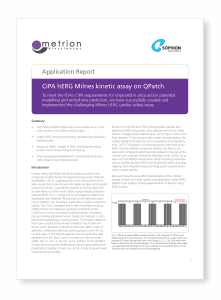CiPA hERG Milnes kinetic assay on QPatch

Application report
Application report title
CiPA hERG Milnes kinetic assay on QPatch
Summary
To meet the FDA’s CiPA requirements for improved in silico action potential modelling and arrhythmia prediction, we have successfully created and implemented the challenging Milnes hERG cardiac safety assay.
Please contact us if you would like any further information regarding our suite of KV 1.3 services or Qube screening services.
Extract
Introduction
Cardiac safety side-effects remain the leading cause of new compound attrition during the drug discovery process (Valentin and Redfern, 2017), suggesting that more robust preclinical in vitro, ex vivo and in vivo assays and models are required to predict human clinical risk. Currently the industry is moving away from an over-reliance on the human Ether-a-go-go related potassium channel (hERG, KV11.1) assay and QT prolongation readouts by developing new initiatives that provide a more balanced assess[1]ment of patient risk, focusing in particular on cardiac arrhythmia liability. The FDA’s Comprehensive in vitro Proarrhythmia Assay (CiPA) initiative and Japanese regulatory authorities (JiCSA, CSAHi) aim to more accurately model and predict arrhythmia risk by including additional human cardiac ion channels in patch clamp electrophysiology screening panels. This broader dataset is then used in sophisticated in silico models of the human ven[1]tricular action potential to predict arrhythmias. After 5 years of extensive collaborative effort by working groups in the UK, EU, US and Japan, it has become apparent that incorporating data obtained from the ‘big 6’ panel of cardiac ion channel assays (hERG, NaV1.5, CaV1.2, KVLQT1, KV4.3, and Kir2.1) into standard in silico action potential models allows the accurate prediction of proarrhythmic liability of most, but not all, clinical drugs with well characterised risk profiles.
Recent work by FDA and CiPA working groups indicate that addition of hERG-drug kinetic data obtained with the so-called ‘Milnes’ voltage protocol (Milnes et al., 2010; Figure 1) to a modified ‘dynamic’ O’Hara-Rudy in silico model correctly predicts the cardiac liability of compounds such as quinidine and cisapride (Li et al., 2017). The kinetics of drug binding and unbinding to the hERG channel underlies compound potency, but there is evidence that compounds which become trapped in the pore of the channel carry a greater clinical risk (Pearlstein et al., 2016). Up to now only high fidelity manual patch clamp recordings have been used to reliably measure hERG channel binding kinetics and drug trapping, both important aspects of drug action and potency as well as cardiac liability.
We report here the successful implementation of the ‘Milnes’ voltage protocol on a high quality automated patch clamp (APC) platform that enables accurate determination of dynamic drug[1]hERG kinetics.
DMSO Stability Cells were voltage clamped at -80 mV and hERG currents were elicited by 10 test pulses comprising a 10 second depolarization applied every 25 seconds (Stage 1), after which cells were held at -80 mV for 250 seconds (Stage 2). This cycle was then repeated (Figure 1) to allow a stable baseline to be achieved. Importantly, after assay optimization, all test pulse responses in DMSO (Stage 9) were similar in profile to that of the last control sweep (Stage 7; Figure 2). A stable baseline is pivotal to the dynamic hERG assay, as changes in hERG current kinetics would appear as drug trapping.
Other recommended publications


Let’s work together
What are your specific ion channel and assay needs?
If you have any questions or would like to discuss your specific assay requirements, we will put you directly in touch with a member of our scientific team. Contact us today to discover more.
